Rapid Quantitation of Coal Proximate Analysis by Using Laser-Induced Breakdown Spectroscopy
Abstract
:1. Introduction
2. Materials and Methods
2.1. Coal Samples
2.2. Experimental Setup
2.3. Spectral Pretreatment
2.4. Chemometric Methods
2.4.1. PCR
2.4.2. ANNs
2.4.3. PCA–ANN
2.5. Model Evaluation Indicators
3. Results and Discussion
3.1. Selection of Characteristic Emission Lines
- High intensity to obtain a high SNR;
- High probability of excitation to ensure the repeatability of the experiment;
- Interference-free spectrum to exclude the influence of spectral line overlap.
3.2. PCR
3.3. ANNs
3.4. PCA-ANN
3.5. Comparison and Analysis
4. Conclusions
Author Contributions
Funding
Institutional Review Board Statement
Informed Consent Statement
Data Availability Statement
Acknowledgments
Conflicts of Interest
References
- Statistical Review of World Energy 2021. Available online: https://www.bp.com/content/dam/bp/business-sites/en/global/corporate/pdfs/energy-economics/statistical-review/bp-stats-review-2021-full-report.pdf (accessed on 14 March 2022).
- Ghetti, P. DTG combustion behaviour of coal: Correlations with proximate and ultimate analysis data. Fuel 1986, 65, 636–639. [Google Scholar] [CrossRef]
- Charbucinski, J.; Nichols, W. Application of spectrometric nuclear borehole logging for reserves estimation and mine planning at Callide coalfields open-cut mine. Appl. Energy 2003, 74, 313–322. [Google Scholar] [CrossRef]
- Parus, J.; Kierzek, J.; Malozewska-Bucko, B. Determination of the carbon content in coal and ash by XRF. X-ray Spectrom. Int. J. 2000, 29, 192–195. [Google Scholar] [CrossRef]
- Ctvrtnickova, T.; Mateo, M.P.; Yañez, A.; Nicolas, G. Application of LIBS and TMA for the determination of combustion predictive indices of coals and coal blends. Appl. Surf. Sci. 2011, 257, 5447–5451. [Google Scholar] [CrossRef]
- Carranza, J.E.; Hahn, D.W. Sampling statistics and considerations for single-shot analysis using laser-induced breakdown spectroscopy. Spectrochim. Acta Part B At. Spectrosc. 2002, 57, 779–790. [Google Scholar] [CrossRef]
- Singh, J.P.; Almirall, J.R.; Sabsabi, M.; Miziolek, A.W. Laser-induced breakdown spectroscopy (LIBS). Anal. Bioanal. Chem. 2011, 400, 3191–3192. [Google Scholar] [CrossRef] [Green Version]
- Rosenwasser, S.; Asimellis, G.; Bromley, B.; Hazlett, R.; Martin, J.; Pearce, T.; Zigler, A. Development of a method for automated quantitative analysis of ores using LIBS. Spectrochim. Acta Part B At. Spectrosc. 2001, 56, 707–714. [Google Scholar] [CrossRef]
- Zhang, Y.; Dong, M.; Cheng, L.; Wei, L.; Cai, J.; Lu, J. Improved measurement in quantitative analysis of coal properties using laser induced breakdown spectroscopy. J. Anal. At. Spectrom. 2020, 35, 810–818. [Google Scholar] [CrossRef]
- Senesi, G.S.; Senesi, N. Laser-induced breakdown spectroscopy (LIBS) to measure quantitatively soil carbon with emphasis on soil organic carbon. A review. Anal. Chim. Acta 2016, 938, 7–17. [Google Scholar] [CrossRef]
- Sezer, B.; Bilge, G.; Boyaci, I.H. Capabilities and limitations of LIBS in food analysis. Trends Analyt. Chem. 2017, 97, 345–353. [Google Scholar] [CrossRef]
- Hahn, D.W.; Omenetto, N. Laser-Induced Breakdown Spectroscopy (LIBS), Part I: Review of Basic Diagnostics and Plasma-Particle Interactions: Still-Challenging Issues within the Analytical Plasma Community. Appl. Spectrosc. 2010, 64, 335A–366A. [Google Scholar] [CrossRef] [Green Version]
- Yang, Y.; Li, C.; Liu, S.; Min, H.; Yan, C.; Yang, M.; Yu, J. Classification and identification of brands of iron ores using laser-induced breakdown spectroscopy combined with principal component analysis and artificial neural networks. Anal. Methods 2020, 12, 1316–1323. [Google Scholar] [CrossRef]
- Zhang, W.; Zhuo, Z.; Lu, P.; Tang, J.; Tang, H.; Lu, J.; Xing, T.; Wang, Y. LIBS analysis of the ash content, volatile matter, and calorific value in coal by partial least squares regression based on ash classification. J. Anal. At. Spectrom. 2020, 35, 1621–1631. [Google Scholar] [CrossRef]
- Zhang, Y.; Xiong, Z.; Ma, Y.; Zhu, C.; Zhou, R.; Li, X.; Li, Q.; Zeng, Q. Quantitative analysis of coal quality by laser-induced breakdown spectroscopy assisted with different chemometric methods. Anal. Methods 2020, 12, 3530–3536. [Google Scholar] [CrossRef] [PubMed]
- Zhang, W.; Zhuo, Z.; Lu, P.; Lu, J.; Sun, T.; Tang, J.; Tang, H.; Zhou, T.; Li, L. Laser-induced breakdown spectroscopy for quantitative and qualitative analysis of the ash fusion temperatures of coal in power plants. J. Anal. At. Spectrom. 2021, 36, 576–589. [Google Scholar] [CrossRef]
- Zhang, T.; Yan, C.; Qi, J.; Tang, H.; Li, H. Classification and discrimination of coal ash by laser-induced breakdown spectroscopy (LIBS) coupled with advanced chemometric methods. J. Anal. At. Spectrom. 2017, 32, 1960–1965. [Google Scholar] [CrossRef]
- Lu, Z.; Mo, J.; Yao, S.; Zhao, J.; Lu, J. Rapid Determination of the Gross Calorific Value of Coal Using Laser-Induced Breakdown Spectroscopy Coupled with Artificial Neural Networks and Genetic Algorithm. Energy Fuels 2017, 31, 3849–3855. [Google Scholar] [CrossRef]
- Yao, S.; Zhao, J.; Xu, J.; Lu, Z.; Lu, J. Optimizing the binder percentage to reduce matrix effects for the LIBS analysis of carbon in coal. J. Anal. At. Spectrom. 2017, 32, 766–772. [Google Scholar] [CrossRef]
- Dixon-Lewis, G.; Marshall, P.; Ruscic, B.; Burcat, A.; Goos, E.; Cuoci, A.; Frassoldati, A.; Faravelli, T.; Glarborg, P. Inhibition of hydrogen oxidation by HBr and Br2. Combust. Flame 2012, 159, 528–540. [Google Scholar] [CrossRef] [Green Version]
- Zhu, W.; Li, X.; Sun, R.; Zhang, Y.; Yan, Y.; Yu, X.; Ren, X. Investigation of mineral-element migration upon pyrolysis and quantitative prediction of volatiles in coal using laser-induced breakdown spectroscopy. J. Anal. At. Spectrom. 2021, 36, 1399–1409. [Google Scholar] [CrossRef]
- Ren, X.; Rokni, E.; Sun, R.; Meng, X.; Levendis, Y.A. Evolution of Chlorine-Bearing Gases during Corn Straw Torrefaction at Different Temperatures. Energy Fuels 2017, 31, 13713–13723. [Google Scholar] [CrossRef]
- Dong, M.; Mao, X.; Gonzalez, J.J.; Lu, J.; Russo, R.E. Time-resolved LIBS of atomic and molecular carbon from coal in air, argon and helium. J. Anal. At. Spectrom. 2012, 27, 2066–2075. [Google Scholar] [CrossRef]
- Liu, H.; Shah, S.; Jiang, W. On-line outlier detection and data cleaning. Comput. Chem. Eng. 2004, 28, 1635–1647. [Google Scholar] [CrossRef]
- Chen, D.; Huang, Z.; Wang, T.; Ma, Y.; Zhang, Y.; Wang, G.; Zhang, P. High-throughput analysis of single particles by micro laser induced breakdown spectroscopy. Anal. Chim. Acta 2020, 1095, 14–19. [Google Scholar] [CrossRef]
- Yu, H.; Xu, Y.; Lv, N.; Chen, H.; Chen, S. Arc spectral processing technique with its application to wire feed monitoring in Al–Mg alloy pulsed gas tungsten arc welding. J. Mater. Process Technol. 2013, 213, 707–716. [Google Scholar] [CrossRef]
- Jolliffe, I. Principal Component Analysis. In Encyclopedia of Statistics in Behavioral Science; Springer Press: New York, NY, USA, 2002; ISBN 9783642048975. [Google Scholar]
- Sjöberg, J.; Zhang, Q.; Ljung, L.; Benveniste, A.; Delyon, B.; Glorennec, P.Y.; Hjalmarsson, H.; Juditsky, A. Nonlinear black-box modeling in system identification: A unified overview. Automatica 1995, 31, 1691–1724. [Google Scholar] [CrossRef] [Green Version]
- El Haddad, J.; Bruyère, D.; Ismaël, A.; Gallou, G.; Laperche, V.; Michel, K.; Canioni, L.; Bousquet, B. Application of a series of artificial neural networks to on-site quantitative analysis of lead into real soil samples by laser induced breakdown spectroscopy. Spectrochim. Acta Part B At. Spectrosc. 2014, 97, 57–64. [Google Scholar] [CrossRef] [Green Version]
- Nourani, V.; Komasi, M.; Alami, M.T. Hybrid Wavelet–Genetic Programming Approach to Optimize ANN Modeling of Rainfall–Runoff Process. J. Hydrol. Eng. 2012, 17, 724–741. [Google Scholar] [CrossRef]
- Shibata, K.; Yusuke, I. Effect of number of hidden neurons on learning in large-scale layered neural networks. In Proceedings of the ICROS-SICE International Joint Conference 2009, Fukuoka, Japan, 18–21 August 2009; IEEE: New York, NY, USA, 2009; pp. 5008–5013. [Google Scholar]
- Hemmateenejad, B. Correlation ranking procedure for factor selection in PC-ANN modeling and application to ADMETox evaluation. Chemometr. Intell. Lab. Syst. 2005, 75, 231–245. [Google Scholar] [CrossRef]
- Sheta, S.; Afgan, M.S.; Hou, Z.; Yao, S.C.; Zhang, L.; Li, Z.; Wang, Z. Coal analysis by laser-induced breakdown spectroscopy: A tutorial review. J. Anal. At. Spectrom. 2019, 34, 1047–1082. [Google Scholar] [CrossRef]
- Liu, K.; He, C.; Zhu, C.; Chen, J.; Zhan, K.; Li, X. A review of laser-induced breakdown spectroscopy for coal analysis. Trends Analyt. Chem. 2021, 143, 327–334. [Google Scholar] [CrossRef]
- Ferreira, E.C.; Anzano, J.M.; Milori, D.M.; Ferreira, E.J.; Lasheras, R.J.; Bonilla, B.; Montull-Ibor, B.; Casas, J.; Martin Neto, L. Multiple response optimization of laser-induced breakdown spectroscopy parameters for multi-element analysis of soil samples. Appl. Spectrosc. 2009, 63, 1081–1088. [Google Scholar] [CrossRef] [PubMed]
- Pořízka, P.; Klus, J.; Képeš, E.; Prochazka, D.; Hahn, D.W.; Kaiser, J. On the utilization of principal component analysis in laser-induced breakdown spectroscopy data analysis, a review. Spectrochim. Acta Part B At. Spectrosc. 2018, 148, 65–82. [Google Scholar] [CrossRef]
- Chatterjee, S.; Singh, M.; Biswal, B.P.; Sinha, U.K.; Patbhaje, S.; Sarkar, A. Application of laser-induced breakdown spectroscopy (LIBS) coupled with PCA for rapid classification of soil samples in geothermal areas. Anal. Bioanal. Chem. 2019, 411, 2855–2866. [Google Scholar] [CrossRef]
- Li, L.N.; Liu, X.F.; Yang, F.; Xu, W.M.; Wang, J.Y.; Shu, R. A review of artificial neural network based chemometrics applied in laser-induced breakdown spectroscopy analysis. Spectrochim. Acta Part B At. Spectrosc. 2021, 180, 106183. [Google Scholar] [CrossRef]
- Pokrajac, D.; Lazarevic, A.; Kecman, V.; Marcano, A.; Markushin, Y.; Vance, T.; Reljin, N.; McDaniel, S.; Melikechi, N. Automatic classification of laser-induced breakdown spectroscopy (LIBS) data of protein biomarker solutions. Appl. Spectrosc. 2014, 68, 1067–1075. [Google Scholar] [CrossRef]
- Fu, Y.T.; Gu, W.L.; Hou, Z.Y.; Muhammed, S.A.; Li, T.Q.; Wang, Y.; Wang, Z. Mechanism of signal uncertainty generation for laser-induced breakdown spectroscopy. Front. Phys. 2020, 16, 22502. [Google Scholar] [CrossRef]
- Drezga, I.; Rahman, S. Input variable selection for ANN-based short-term load forecasting. IEEE Trans. Power Syst. 1998, 13, 1238–1244. [Google Scholar] [CrossRef]
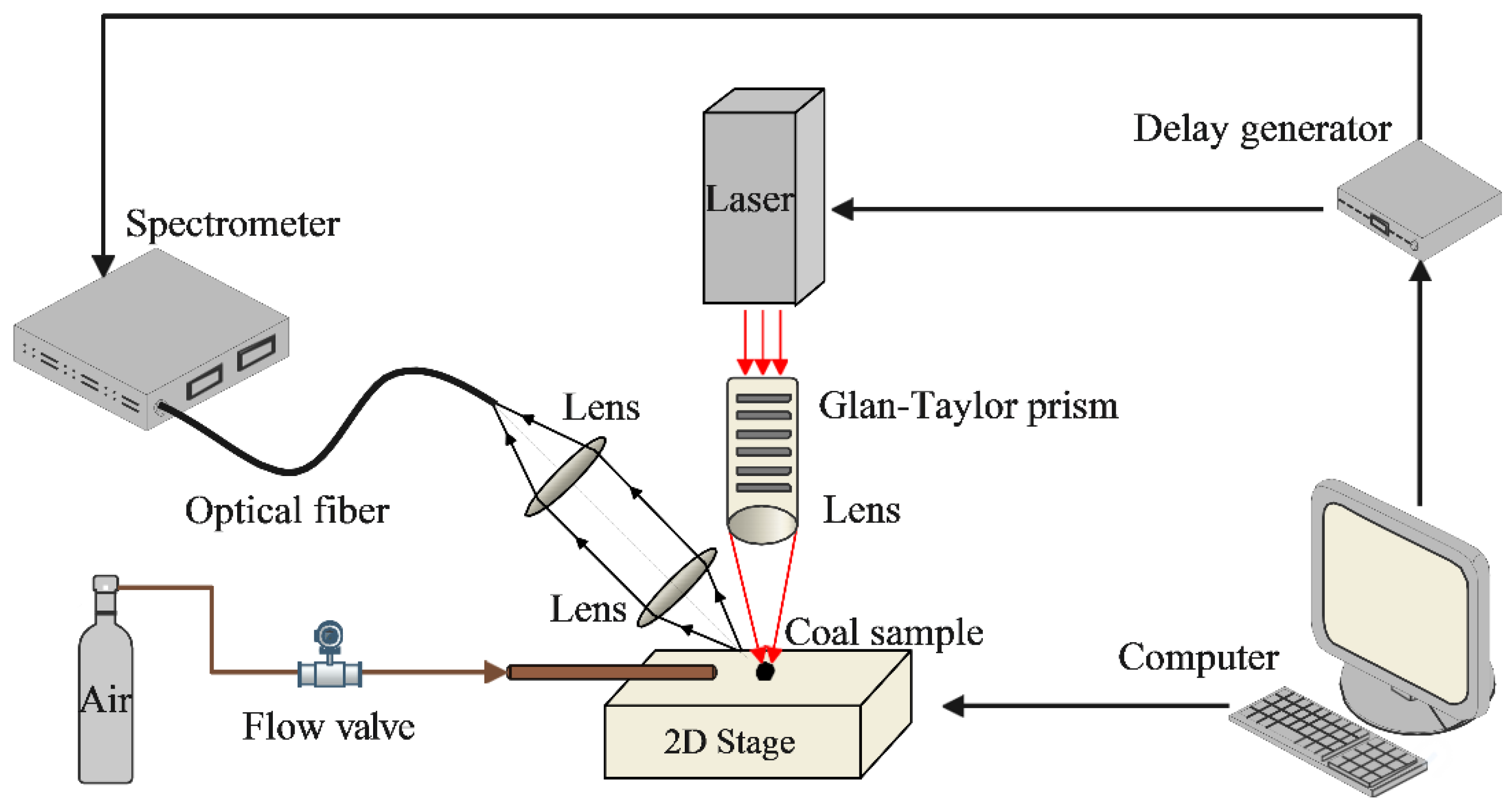
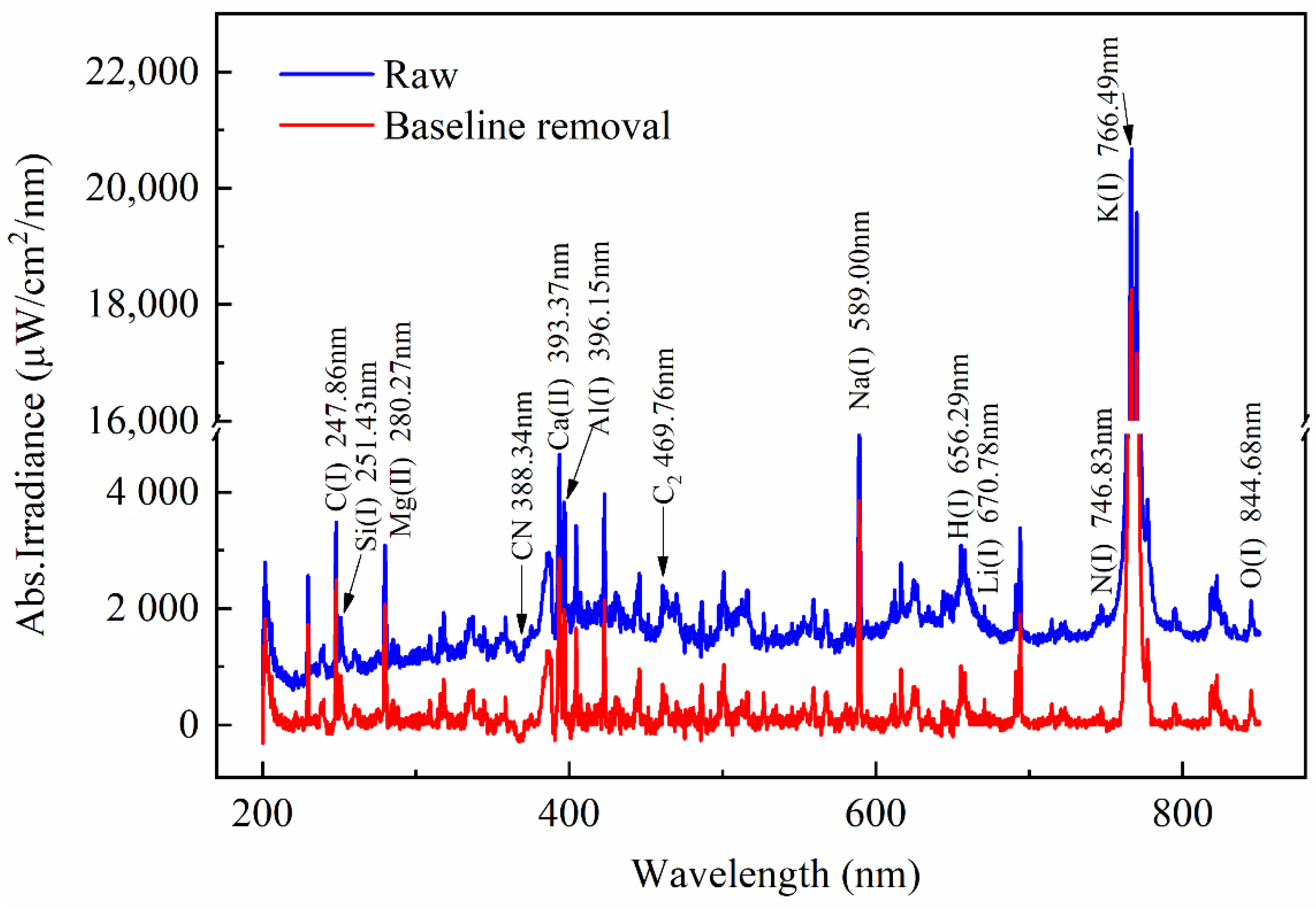
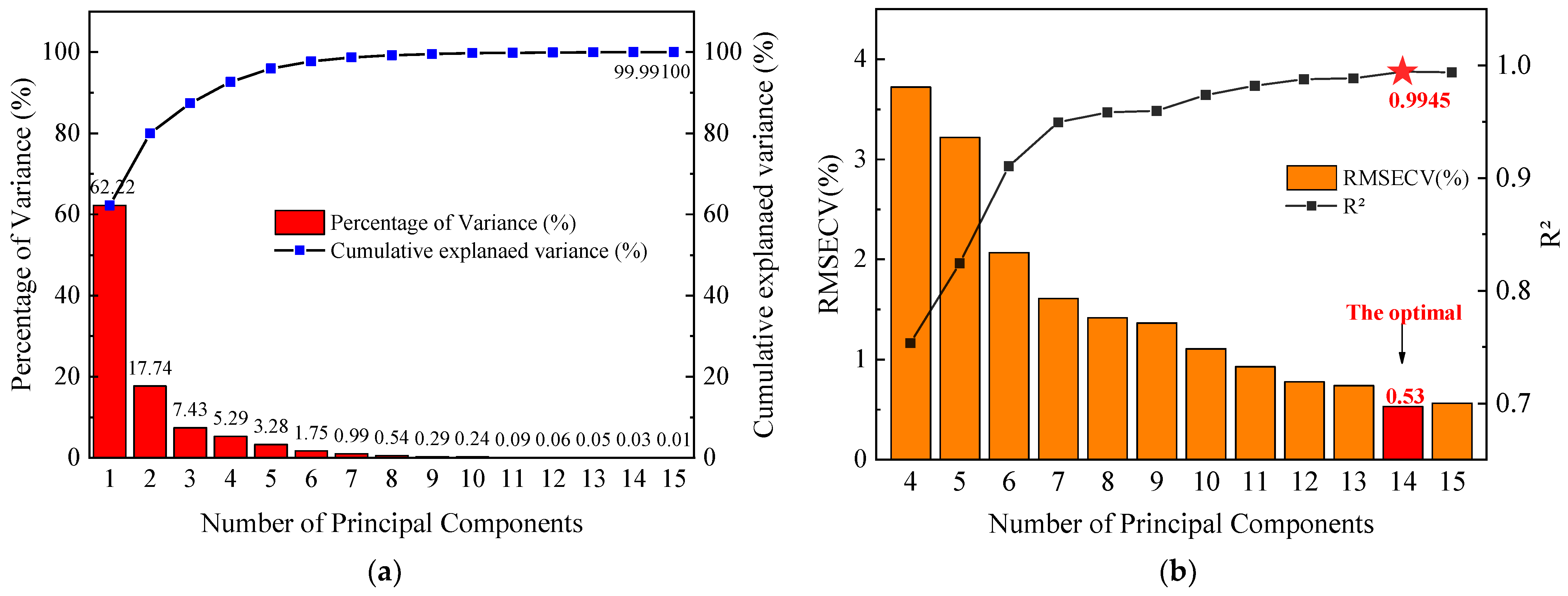
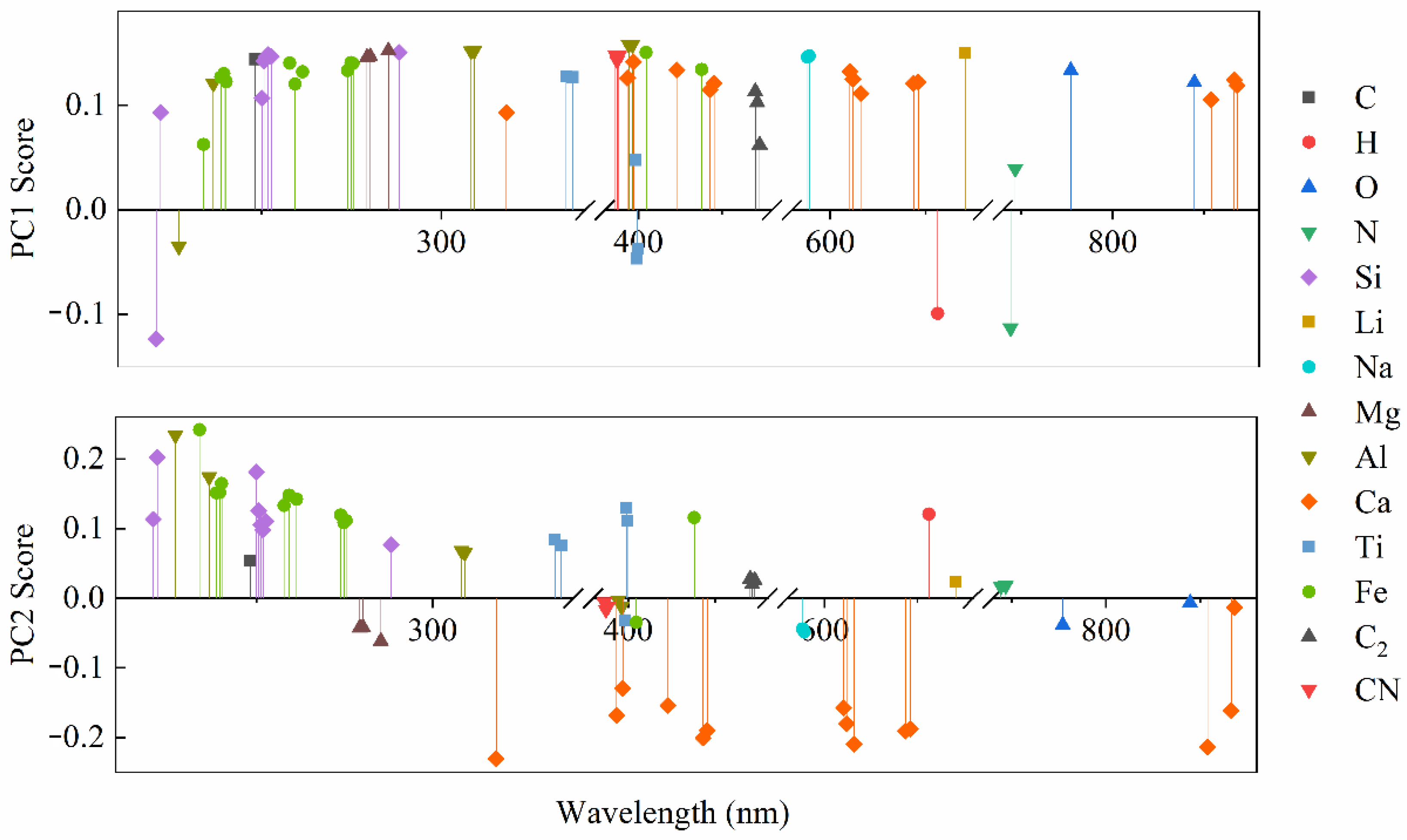
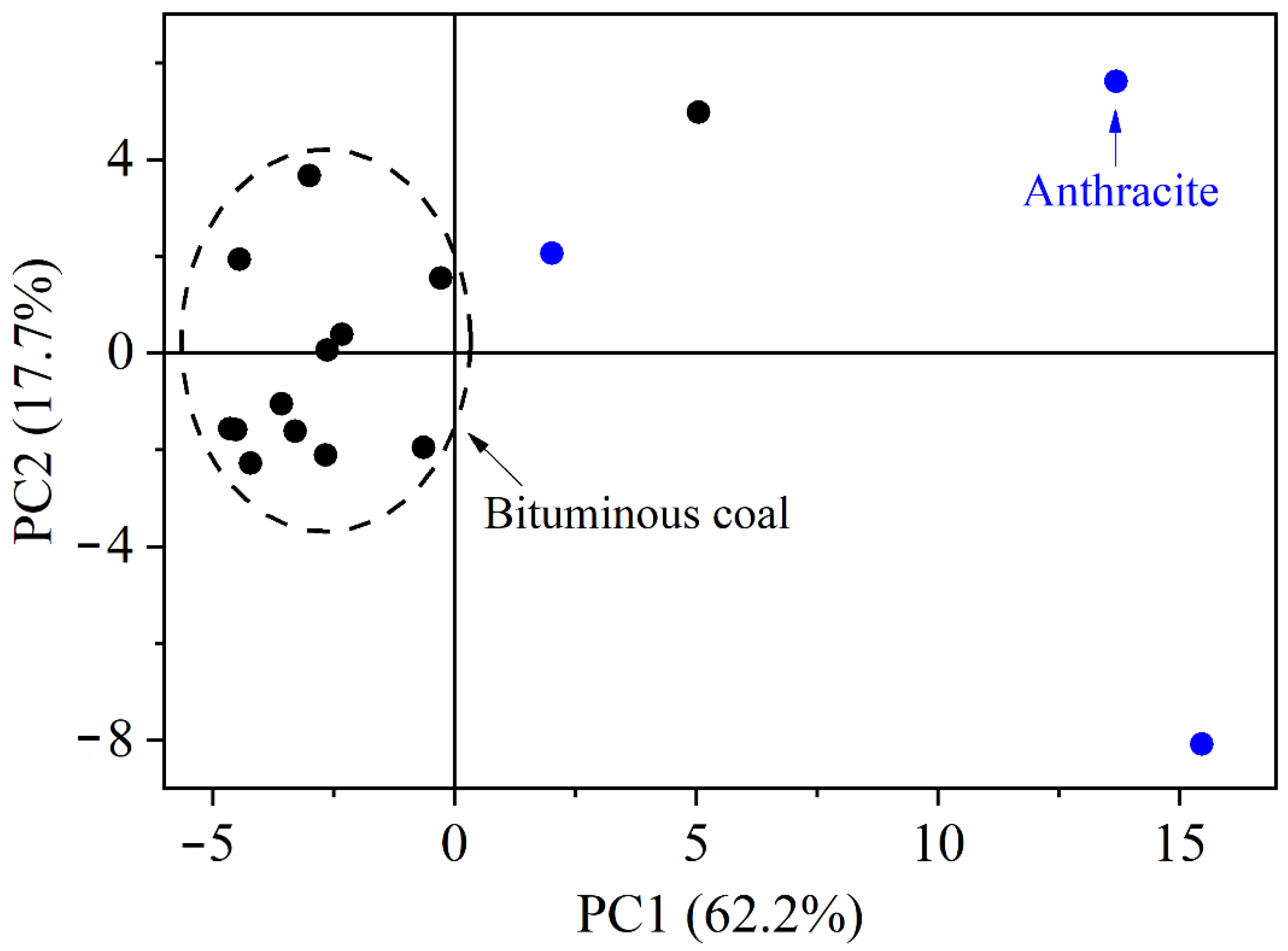

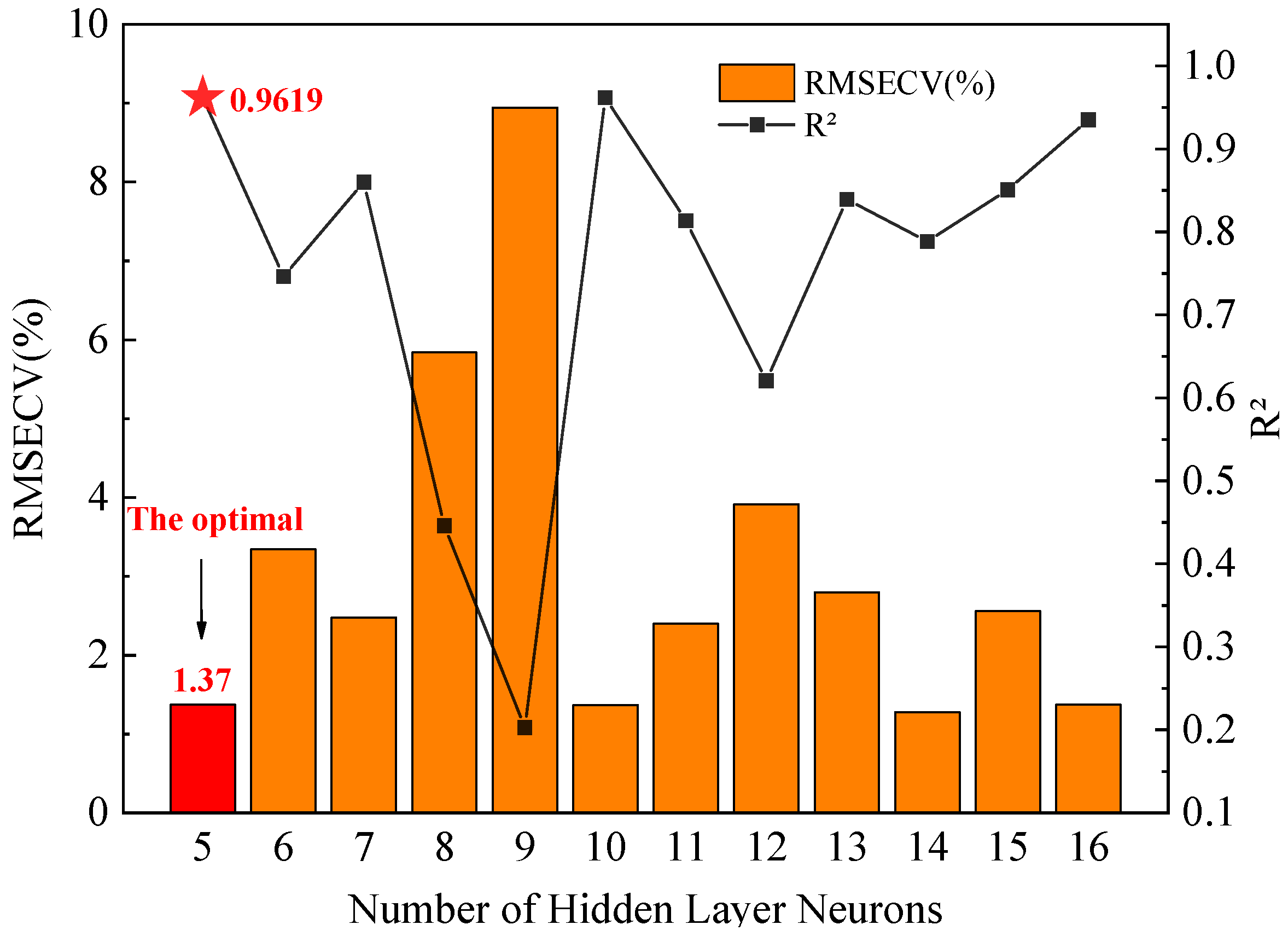
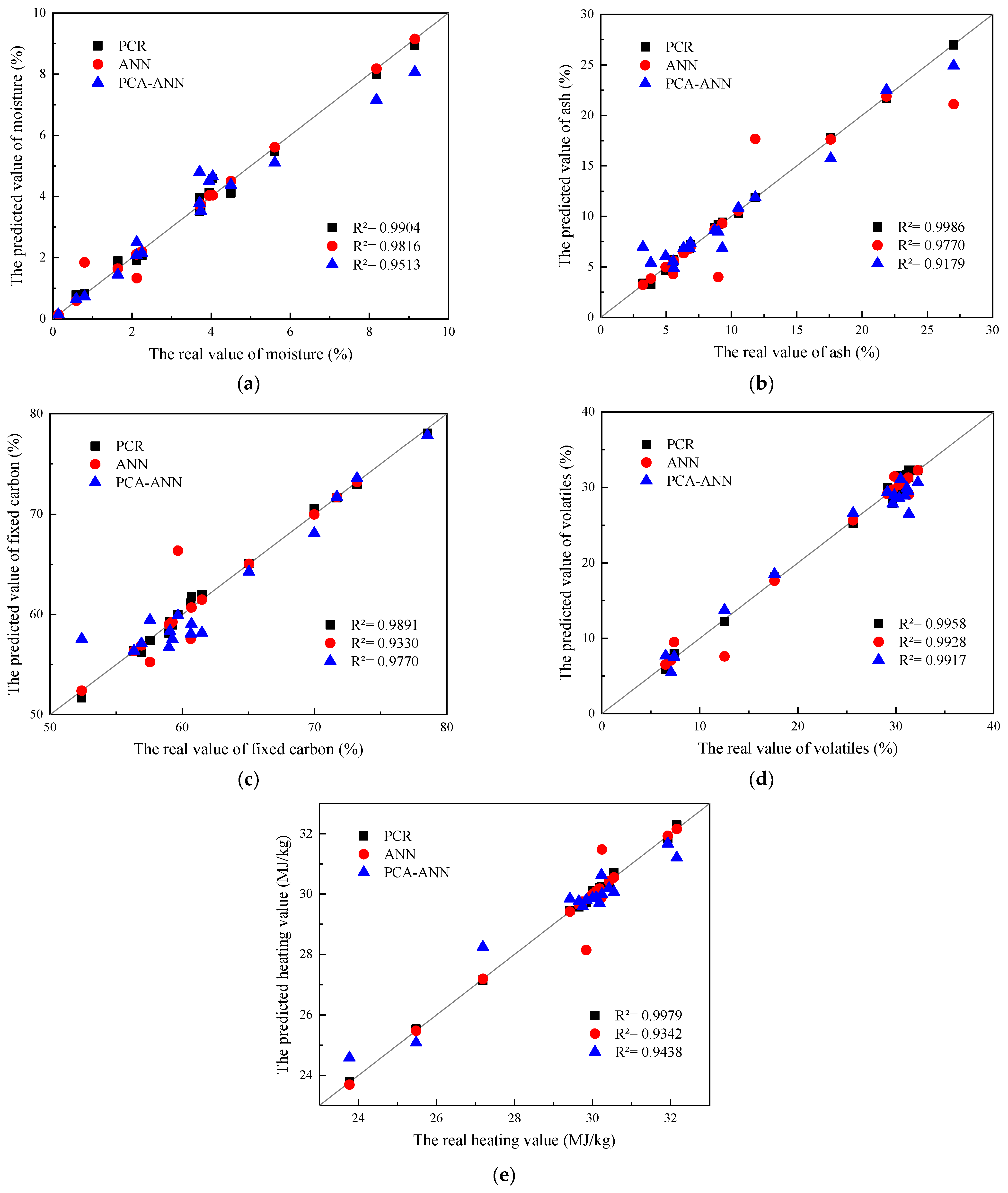
| No. | Moisture | Volatiles | Ash | Fixed Carbon 1 | Heating Value | Coal Type 2 |
|---|---|---|---|---|---|---|
| (wt. %) | (wt. %) | (wt. %) | (wt. %) | (MJ/kg) | ||
| 1 | 9.15 | 29.15 | 9.31 | 52.39 | 29.42 | Bituminous coal |
| 2 | 5.61 | 31.13 | 6.35 | 56.91 | 29.65 | Bituminous coal |
| 3 | 3.71 | 30.49 | 6.81 | 58.99 | 30.18 | Bituminous coal |
| 4 | 2.12 | 31.33 | 9.00 | 57.55 | 29.84 | Bituminous coal |
| 5 | 3.74 | 30.94 | 3.84 | 61.48 | 30.55 | Bituminous coal |
| 6 | 3.95 | 29.86 | 5.55 | 60.64 | 30.24 | Bituminous coal |
| 7 | 8.18 | 32.25 | 3.23 | 56.34 | 29.75 | Bituminous coal |
| 8 | 4.50 | 31.28 | 4.97 | 59.25 | 30.00 | Bituminous coal |
| 9 | 3.71 | 30.35 | 6.87 | 59.07 | 30.09 | Bituminous coal |
| 10 | 4.04 | 29.68 | 5.59 | 60.69 | 30.42 | Bituminous coal |
| 11 | 0.14 | 17.63 | 10.54 | 71.69 | 32.16 | Bituminous coal |
| 12 | 2.11 | 7.07 | 17.61 | 73.21 | 27.19 | Anthracite |
| 13 | 2.25 | 7.38 | 11.83 | 78.54 | 30.23 | Anthracite |
| 14 | 0.59 | 25.65 | 8.72 | 65.04 | 31.93 | Bituminous coal |
| 15 | 0.80 | 12.52 | 27.01 | 59.67 | 23.77 | Bituminous coal |
| 16 | 1.64 | 6.51 | 21.87 | 69.98 | 25.48 | Anthracite |
| Type | Name | Emission Lines 1 (nm) |
|---|---|---|
| Organic atom | C | 247.86 (Ⅰ 2) |
| H | 656.29 (Ⅰ) | |
| O | 777.19 (Ⅰ), 844.68 (Ⅰ) | |
| N | 744.23 (Ⅰ), 746.83 (Ⅰ) | |
| Inorganic atom | Si | 220.80 (Ⅰ), 221.67 (Ⅰ), 250.69 (Ⅰ), 251.43 (Ⅰ), 251.61 (Ⅰ), 251.92 (Ⅰ), 252.85 (Ⅰ), 288.16 (Ⅰ) |
| Li | 670.78 (Ⅰ) | |
| Na | 589.00 (Ⅰ), 589.59 (Ⅰ) | |
| Mg | 279.55 (Ⅱ 3), 280.27 (Ⅱ), 285.21 (Ⅰ) | |
| Al | 226.91 (Ⅰ), 237.31 (Ⅰ), 308.22 (Ⅰ), 309.27 (Ⅰ), 394.40 (Ⅰ), 396.15 (Ⅰ) | |
| Ca | 315.89 (Ⅱ) 317.93 (Ⅱ), 393.37 (Ⅱ), 396.85 (Ⅱ), 422.67 (Ⅰ), 443.50 (Ⅰ), 445.48 (Ⅰ), 610.27 (Ⅰ), 612.22 (Ⅰ), 616.13 (Ⅰ), 643.91 (Ⅰ), 646.26 (Ⅰ), 854.21 (Ⅱ), 866.21 (Ⅱ) | |
| Ti | 334.94 (Ⅱ), 336.12 (Ⅱ), 398.18 (Ⅰ), 398.96 (Ⅰ), 399.90 (Ⅰ) | |
| Fe | 234.35 (Ⅱ), 238.18 (Ⅰ), 239.33 (Ⅱ), 240.48 (Ⅱ), 258.55 (Ⅰ), 260.65 (Ⅱ), 261.11 (Ⅱ), 273.92 (Ⅰ), 274.89 (Ⅱ), 275.55 (Ⅰ), 404.58 (Ⅰ), 461.88 (Ⅰ) | |
| Molecule | C2 | 469.76, 471.52, 473.71 |
| CN | 386.19, 387.14, 388.34 |
| Proximate Analysis | Methods | R2 | RMSECV | MSE | Modeling Time |
|---|---|---|---|---|---|
| (%) | (s) | ||||
| Moisture | PCR | 0.9904 | 0.2458 | 0.0565 | 10 |
| ANN | 0.9816 | 0.3386 | 0.1082 | 89 | |
| PCA-ANN | 0.9513 | 0.5555 | 0.2887 | 28 | |
| Ash | PCR | 0.9986 | 0.2455 | 0.0564 | 10 |
| ANN | 0.9770 | 1.0060 | 0.9496 | 85 | |
| PCA-ANN | 0.9179 | 1.8955 | 11.6299 | 25 | |
| Fixed carbon | PCR | 0.9891 | 0.6620 | 0.4097 | 10 |
| ANN | 0.9330 | 1.6334 | 2.5081 | 90 | |
| PCA-ANN | 0.9770 | 0.5765 | 1.7799 | 30 | |
| Volatiles | PCR | 0.9958 | 0.6857 | 0.4399 | 10 |
| ANN | 0.9928 | 0.8973 | 0.7579 | 79 | |
| PCA-ANN | 0.9917 | 1.6452 | 24.5579 | 22 | |
| Heating value | PCR | 0.9979 | 0.0980 | 0.0900 | 10 |
| ANN | 0.9342 | 0.5482 | 0.2837 | 83 | |
| PCA-ANN | 0.9438 | 0.5120 | 0.2452 | 24 |
Publisher’s Note: MDPI stays neutral with regard to jurisdictional claims in published maps and institutional affiliations. |
© 2022 by the authors. Licensee MDPI, Basel, Switzerland. This article is an open access article distributed under the terms and conditions of the Creative Commons Attribution (CC BY) license (https://creativecommons.org/licenses/by/4.0/).
Share and Cite
Liu, Y.; Wang, D.; Ren, X. Rapid Quantitation of Coal Proximate Analysis by Using Laser-Induced Breakdown Spectroscopy. Energies 2022, 15, 2728. https://doi.org/10.3390/en15082728
Liu Y, Wang D, Ren X. Rapid Quantitation of Coal Proximate Analysis by Using Laser-Induced Breakdown Spectroscopy. Energies. 2022; 15(8):2728. https://doi.org/10.3390/en15082728
Chicago/Turabian StyleLiu, Yulin, Dongming Wang, and Xiaohan Ren. 2022. "Rapid Quantitation of Coal Proximate Analysis by Using Laser-Induced Breakdown Spectroscopy" Energies 15, no. 8: 2728. https://doi.org/10.3390/en15082728






